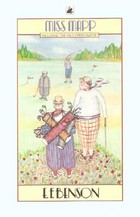‘Miss Mapp’ by E. F. Benson
 Although I only discovered E. F. Benson this year (and I still wonder why it took me so long) he’s fast become one of my go-to writers when I need a comfort read. When I was feeling ill and in need of some cheering recently I turned to the next book in Benson’s Mapp and Lucia series, in which I left behind the familiar sights and residents of Riseholme, even Queen Lucia herself, and instead I met the formidable Miss Mapp for the first time.
Although I only discovered E. F. Benson this year (and I still wonder why it took me so long) he’s fast become one of my go-to writers when I need a comfort read. When I was feeling ill and in need of some cheering recently I turned to the next book in Benson’s Mapp and Lucia series, in which I left behind the familiar sights and residents of Riseholme, even Queen Lucia herself, and instead I met the formidable Miss Mapp for the first time.
Miss Mapp lives in Tilling, a village every bit as concerned with keeping up appearances and being one step ahead of one’s neighbours as Riseholme is. She observes the comings and goings of her friends and acquaintances through her opera glasses from the bay window of her perfectly positioned house and, though she is shrewd (particularly when it comes to schemes for outwitting her neighbours), she frequently misinterprets or misjudges what she sees. Incidents include beating her friend to a new dress, trying to attract the attentions of two retired officers who are far more interested in golf, and attempting to see the king as he goes through Tilling on his train while pretending complete disinterest in his visit.
Although Miss Mapp and Lucia are the same type of character engaged in the same type of activity in the same type of setting, Benson manages to make them impressively different. While Lucia is Riseholme’s undisputed ruler in spite of her flaws, Miss Mapp is on a much more even footing with the residents of Tilling. Consequently, her scheming is more agressive and less good-natured because she has further to go to get ahead of people. She reminds me more of Daisy than she does Lucia. The way Benson ties together her physical appearance and her character is very well done, particularly the way he skirts round using the word ‘fat’:
In spite of her malignant curiosity and her cancerous suspicions about all her friends, in spite, too, of her restless activities, Miss Mapp was not, as might have been expected, a lady of lean and emaciated appearance. She was tall and portly, with plump hands, a broad, benignant face and dimpled, well-nourished cheeks. An acute observer might have detected a danger warning in the sidelong glances of her rather blugy eyes, and in a certain tightness at the corners of her expansive mouth, which boded ill for any who came within snapping distance, but to a more superficial view she was a rollicking, good-natured figure of a woman.
Quaint Irene is an excellent character and a thoroughly welcome addition to the mixture of characters who populate Tilling. She stands out not only for her eccentricities, dressing in boyish clothing (including knickerbockers), displaying socialist tendencies and painting nude portraits of the local fishmonger, but also for her entirely different attitude. Although she enjoys bridge just as much as the next resident of Tilling, unlike the rest she shows no interest in the petty one-upmanships in which they are constantly engaged. She is level-headed and sensible, and her no-nonsense approach provides an effective counterpoint to the silly manoeuvrings and petty squabbles of her fellows. I really hope that she comes to visit Riseholme as I’d love to see how she fits in there.
Although Miss Mapp is easily as entertaining as Queen Lucia and Lucia in London (which remains my favourite so far), it does feel a bit darker, or as dark as you can get within the spectrum of E. F. Benson novels anyway. In Riseholme everyone gets on, for all their grumbles and complaints about each other, but in Tilling the characters will accuse each other of their actions rather than letting them slide. At times it feels nasty rather than gossipy, which is a bit of a change. There are also elements of out-and-out backstabbing between the characters (the incident with the applique dress springs to mind particularly) when they do things specifically to wound another person rather than for the sake of being head of the latest craze or connected to the most important people. Additionally, the outside world intrudes into Miss Mapp more than it does in the previous two books. Riseholme exists in a bubble, whereas in Tilling there are references to new taxes being imposed and to rationing on food and fuel. Money is never an issue in Riseholme, but the population of Tilling are thrifty and worry about paying their bills. It is still a comic novel and the tone is as light as always, but there are more serious undercurrents running through Miss Mapp which I hadn’t expected.
I’m really looking forward to seeing the clash of the titans which is coming up in the next book I have ahead of me, Mapp and Lucia. I wonder who will win, or if the two of them will join forces? If they did, they would be unstoppable!
Miss Mapp by E. F. Benson. Published by Black Swan, 1984, pp. 267. Originally published in 1922.